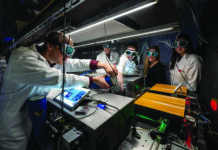
Sources of air pollution on construction sites or quarries could be cheaply and easily located, using low-cost sensors and a new methodology, according to research findings.
The study, published in Climate and Atmospheric Science on 22 August demonstrates how low-cost sensors costing a fraction of the price of existing regulation alternatives can be used to manage air quality in a range of applications including industrial settings and for traffic. The team of atmospheric scientists, and company DustScanAQ have developed a new methodology to determine the specific sources of air pollution, which is currently a challenging and labour-intensive process that requires specialised laboratories.
The HS2 construction site at Curzon Street in the heart of Birmingham was one of the sites used to test the new methodology. The team were able to identify two hotspots of particle emissions on the site, as well as being able to filter out background pollution. This provides an insight into the real-world conditions on a site and demonstrates how real-time monitoring of air quality could be achieved in construction.
Francis Pope, Professor of Atmospheric Science at the University of Birmingham and senior author of the paper said: “Successful air quality management and control not only requires measurement of air pollution levels, but it also requires information on the sources and their relative importance. Without this critical, targeted information on pollution sources, it is difficult to plan and enact cost effective control measures with which to reduce air pollution. Low-cost sensors already help in the measurement of air quality but there is still a major gap for source apportionment.
“This latest study showcases the combination of an elegant methodology for analysing real-time data from inexpensive sensors. It provides a potentially powerful solution for industry, local government and a whole host of other organisations to understand the air quality around them, and also provides a way forward to meet the Government’s legal duty on air quality standards.”
Gordon Allison of DustScanAQ said: “This is really exciting for the application of UK science around the world in the environmental management of quarries, mines and heavy industries. The team from the University of Birmingham have used cheap sensors and complex maths to describe the natural phenomenon that pollution sources emit particles in patterns with recognisable fingerprints. The technique is so cheap relative to the previous state of the art that it will become dominant in discovering pollution sources. Together we hope to make the world a cleaner place.”
Andrea Davidson, Head of Environmental Sciences for HS2 Ltd said: “HS2 has ambitious environmental targets, including dust mitigation, strict emission standards and moving to all diesel-free construction sites by 2029, aimed at reducing impacts on local air quality. This is a great example of how HS2 works with researchers and manufacturers to support positive change across the construction sector. Advances in dust monitoring, like this, will increase confidence in controls, and support the whole sector’s move towards cleaner construction.”
Roadside sensing
Local communities could also benefit from the introduction of low-cost sensors that could be installed at roadside sites or other local pollution hotspots. An installation of sensors in the village of Charlbury, Oxfordshire demonstrates the potential for their use with the methodology to understand variations in pollution in local environments.
Dr Dimitrios Bousiotis, Research Fellow in Source Apportionment at the University of Birmingham and first author of the study said: “The paper showcases an exciting opportunity to put air quality sensing into the hands of more people and organisations so they can understand the environment around them and do something about it. Air pollution is an ongoing problem and recent studies have shown the implications of particulate matter for a range of human health conditions. Monitoring and locating air quality therefore can be a powerful way to enable communities to understand the air they are breathing, and businesses to ensure that they are meeting important air quality standards in their work.”







